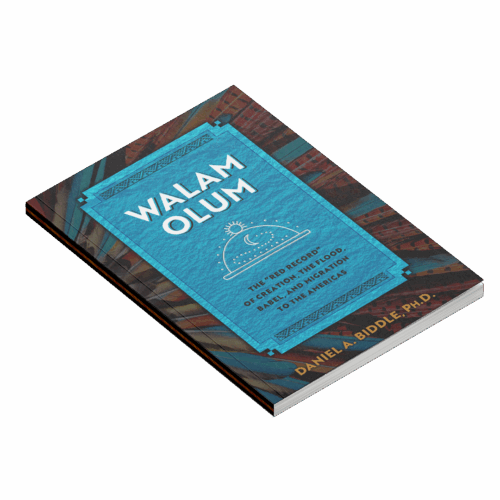
“He made the sun, the moon, and the stars.”
THE WALAM OLUM
Is it possible that a set of wooden tablets with ancient glyphs handed down over the centuries carried the true history of the native American Lenni Lenape people? Does this history overlap the biblical account so strongly that they are retelling the same past about Creation, the beginning of mankind, Satan’s role in corrupting the earth and humanity, the worldwide Flood, and Noah’s role in saving the human line?
In 1836, botanist and antiquarian Constantine Samuel Rafinesque published the Walam Olum (sometimes known as the “Red Record” or “Red Score”) that was based on a set of wooden tablets containing 183 glyphs that were committed to memory by song by the Lenni Lenape Native Americans. This history—passed through generations for over 3,000 years—describes the Creation account, the Great Flood, the struggle between man and evil, the giants, and the narrative of a series of migrations led by 95 chiefs from Asia to America. This document was largely taken at face value since its inception until the 1990s, when it was attacked by skeptics. Recent genetic breakthroughs, however, have trumped these doubts and revealed that the Walam Olum presents a reliable historical record—one that clearly supports and overlaps the Biblical account outlined in Genesis.
THE STORY
On Monday, October 16, 1679, Dutch traveler Jasper Danckaerts met an 80-year-old Lenni Lenape native man in present day New Jersey. This man told the Creation story according to his people. Although with discrepancies, it resembled closely to the biblical account: the earth, mankind, and all living things were created by their Creator.
141 years later, a Lenape historian named Olumpees fell ill. He gave his doctor the 183-glyph Walam Olum. His doctor, in turn, gave the wooden tablets to a friend, Constantine Samuel Rafinesque, a professor at Translyvania University in Kentucky. Rafinesque was fluent in over 12 languages, and he spent 14 years of carefully deciphering the glyphs with the help from native experts. In 1836, he published the Walam Olum as a book.
WHY IS THIS IMPORTANT?
The Walam Olum carries the history of the Lenni Lenape people for centuries, all the way back to the beginning where it describes the Creator, the Great Manitou, creating the world, sun, moon, stars, land, water, and all living things. Harmony is then disrupted when the evil Manitou, the black snake, brings chaos, sickness, death, and conflict into the world. Next comes a catastrophic Flood, but humanity is rescued by Nanabush, who is considered the grandfather of all men. As their story continues, thousands of them head to America, crossing the Bering Sea. Along this journey, they face harsh climates, beasts, famine, and wars with the dreaded snake people called the Makowini, or the “big men,” giants who practiced dark magic and were associated with the Evil Snake.
When it first emerged, the Walam Olum faced intense scrutiny, but scholars nevertheless found it to be credible. Prominent 19th-century scholars like Daniel Brinton and Smithsonian contributor E. G. Squier published extensive studies affirming its authenticity as Lenape history. Decades later, a 1954 publication by the Indiana Historical Society also strongly supported its credibility.
Then in the 1990s, the credibility of the Walam Olum came under attack. There is one main reason: it aligns closely with Scripture.
But the tables turned just a few year ago. Harvard-trained geneticist Dr. Nathaniel Jeanson revealed overwhelming support for its validity. By tracing the Y chromosome markers, Jeanson confirmed the migratory routes, direction, and even timing in the Walam Olum.
Other researchers such as David McCutchen and E. P. Grondine have also confirmed the Walam Olum migration route using archaeological evidence. Grondine points out that it would require Rafinesque to have “superhuman imagination” to “dream up” the migration account and timing described in the Walam Olum; there is no way he could have possible known where at least six of the tribes described in the Walam Olum lived. Such historic information was confirmed by archaeological findings after the Walam Olum was recorded by Rafinesque.
SIMILARITY WITH THE BIBLE
The Walam Olum has incredible overlap with the Bible. It speaks of the one Great Manitou who made all things, beginning first with the earth, filling it with everything needed for life, then creating man and woman after. There is then the Evil Black Snake, hater of mankind who brought turmoil and evil. Then comes the Makowini, the big men, or giants, which is written about in Genesis 6.
The similarity shows how themes consistent with the Bible—Creation, a global flood, giants—were carried by people across the globe after Babel.
To learn more about the Walam Olum, watch our upcoming video on our YouTube channel, along with our forthcoming movie Out of Babel.
SEE THE EVIDENCE YOURSELF
Check out our book, Walam Olum: The “Red Record” of Creation, the Flood, Babel, and Migration to the Americas.

Here are 8 glyphs from the Walam Olum with their English interpretation, followed by their biblical similarities.
WALAM OLUM: BOOK 1

1
At first, in that place, at all times, above the earth,

2
On the earth, [was] an extended fog, and there the great Manito was.

3
At first, forever, lost in space, everywhere, the great Manito was.

4
He made the extended land and the sky.

5
He made the sun, the moon, the stars.

6
He made them all to move evenly.

7
Then the wind blew violently, and it cleared, and the water flowed off far and strong.

8
And groups of islands grew newly, and there remained.
GENESIS: VERSES 1:1–9
1
In the beginning God created the heavens and the earth.
2
The earth was without form, and void; and darkness was on the face of the deep. And the Spirit of God was hovering over the face of the waters.
3
Then God said, “Let there be light”; and there was light.
4
And God saw the light, that it was good; and God divided the light from the darkness.
5
God called the light Day, and the darkness He called Night…
6
Then God said, “Let there be a firmament in the midst of the waters, and let it divide the waters from the waters.”
7
Thus God made the firmament, and divided the waters which were under the firmament from the waters which were above the firmament; and it was so.
8
And God called the firmament Heaven…
9
Then God said, “Let the waters under the heavens be gathered together into one place, and let the dry land appear”; and it was so.
10
And God called the dry land Earth, and the gathering together of the waters He called Seas. And God saw that it was good.
14
Then God said, “Let there be lights in the firmament of the heavens to divide the day from the night; and let them be for signs and seasons, and for days and years;
15
and let them be for lights in the firmament of the heavens to give light on the earth”; and it was so.
16
Then God made two great lights: the greater light to rule the day, and the lesser light to rule the night. He made the stars also.
17
God set them in the firmament of the heavens to give light on the earth,
18
and to rule over the day and over the night, and to divide the light from the darkness. And God saw that it was good.
SCIENTIFIC EVIDENCE
Harvard-trained molecular biologist Dr. Nathaniel Jeanson recently discovered genetic confirmation of both the direction and the timing of the Lenni Lenape migrations described in the Walam Olum. Dr. Jeanson’s research therefore confirms the historical validity of the Walam Olum. See the evidence in this video:
